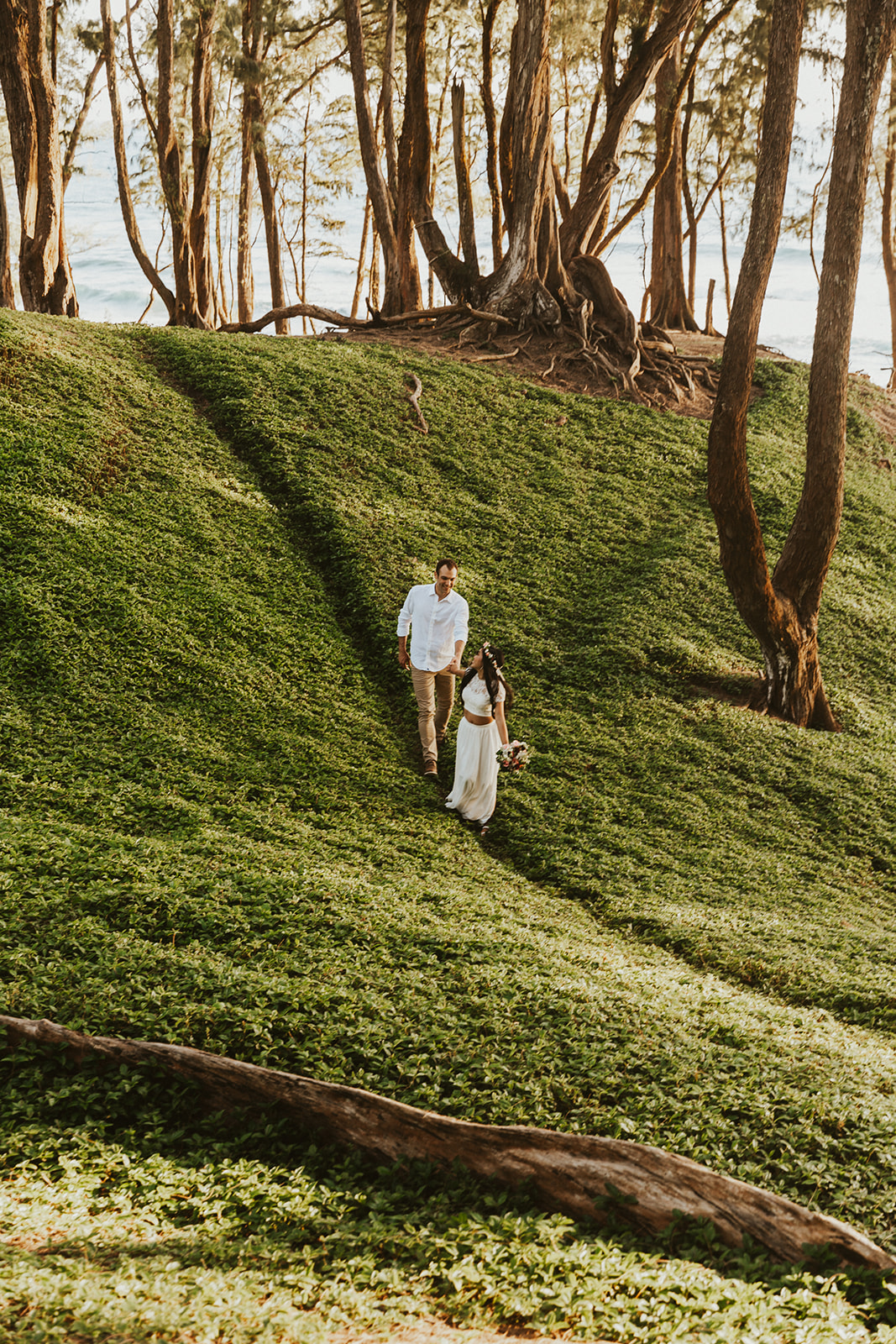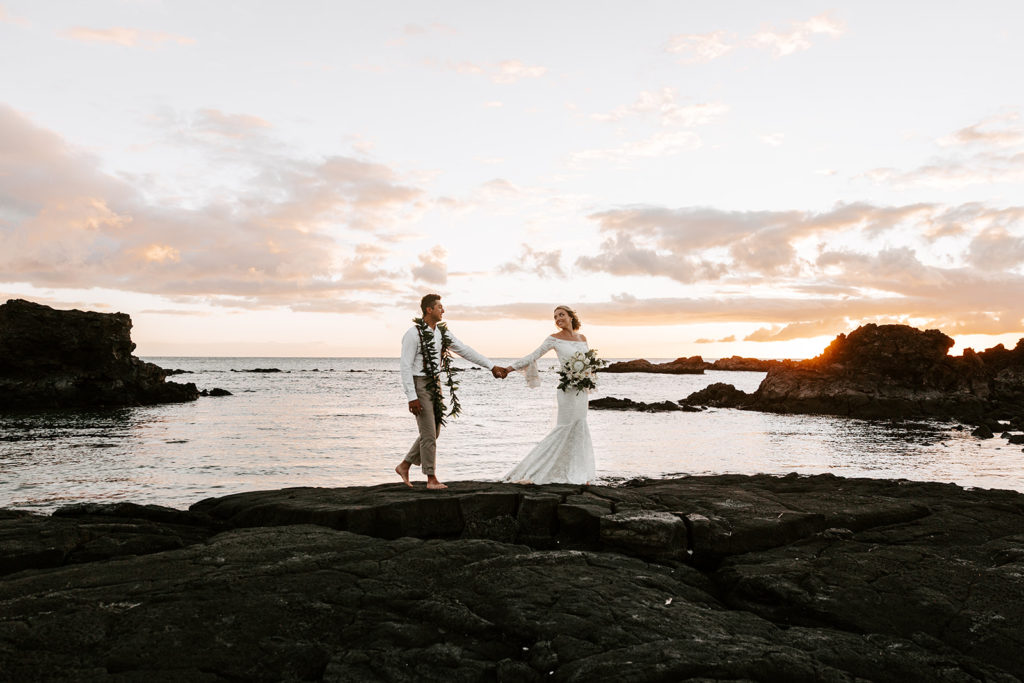
Tips for Your First Hawaii Visit
You’ve booked your plane tickets, Airbnb, and have your elopement date set (complete with me as your photographer, haha!). The excitement leading up to your Hawaii trip is palpable, and your trip is GETTING REAL!!!! Woohoo!
Before you arrive to Hawaii it’s important to learn a little more about the environment and how that might affect your packing list! It is our job as humans to recreate responsibly: for both ourselves and the planet! Read on to discover things you may not know about visiting the Aloha State:
What to Pack: Don’t Forget to Back these Often Overlooked Items for your Trip to Hawaii
Reef-safe sunscreen is a must. Sunscreen that is reef-safe helps keep our reefs, oceans, and the animals that live here healthy!
- Some brands I love are Little Hands, Raw Elements, and Manda! If all else fails, you can locate SunBum at your local Target, but just remember that it must be the “mineral” formula, usually in white packaging.
Reusable shopping bags! Plastic bags are banned in Hawaii so you will notice that when you are shopping for groceries, clothings, and souvenirs, stores will off the purchase of brown paper bags or reusable bags! It can be helpful to be prepared and bring your own 🙂
Sunglasses! The sunshine is radiant here, and with the sun reflecting off of the ocean and sands, you’ll be glad you packed sunglasses for your Hawaii trip.
Sun protection: a floppy hat or baseball cap is a must. For a stylish option, I love Hawaiian Style Pāpale hats!
Reusable water bottles. We want to do our part to cut down on the amount of waste that goes into landfills. Packing a reusable water bottle for your visit to Hawaii can help! I highly recommend an insulated water bottle like a Hydro Flask or Stanley to keep your water bottle cool from the Hawaiian sun.
Don’t forget a portable phone charger! While you are adventuring amongst the Hawaiian Islands, you may be snapping photos and using GPS. You definitely want to avoid a dead phone battery if you can help it!
A Sweater and Rain Jacket. While Hawaii has nice weather year round, in the evenings the temperatures drop enough that it gets much cooler. This is especially true if you are staying at a higher elevation, or walking along the beach at sunset when the winds pick up. We also get lots of rain showers on and off throughout the day depending on what part of the island you are!
ʻŌlelo Hawaiʻi: Common Words used in Hawaii
Hawaiian language (ʻŌlelo Hawaiʻi) is still a central part of Hawaiian culture and day to day life in Hawaii. You will notice Hawaiian language on street signs, names of places you will visit, bathroom signs, and throughout your trip in day to day activities. Here a few words and tips to help!
- Mahalo – Thank you!
- Aloha – Hello and Goodbye
- kāne– Man (often labeled for men’s restroom)
- wahine – Woman (often labeled for women’s restroom)
- Māhū – “Māhūs are third-gender people with additional spiritual and social roles” (learn more about Māhūs in pacific indigenous culture here)
- Mauka – inland (often used as a directional reference for a location up the mountain, mountainside on Hawai’i Island, people will say, “up mauka” or “mauka side”)
- Makai – ocean (often used as a directional reference for up the mountain, mountainside on Hawai’i Island, people will say, or “makai side”)
- Wana – sea urchin (pronounced “vah-na”) – look out for wana, black long spined sea urchins when entering parts of the ocean that are not sandy. You don’t want to step on one of these!
- Mauna – mountain (Hawai’i Island also known as Big Island has both Mauna Kea and Mauna Loa)
- E Komo Mai – welcome (literally translating more to come on in, e komo mai is commonly substituted for welcome. You may see it or hear it when deplaning in Hawaii for the first time or driving out of the airport.)
- Kapu – no tresspassing, keep out, prohibited. If you a see a sign when you are hiking or exploring that says “kapu” do not go there! These are often culturally sacred sites or private property.
- Heiau – pre-christian place of worship or ancient Hawaiian temple. These are sacred sites are often preserved. They typically look like a large rectangular formation of stacked rocks or stone platforms. Do not walk on top of these. Walk around and observe. There will usually be a sign explaining what it is and many of these are now historical sites you can visit.
- TIPS: The “w” in ʻŌlelo Hawaiʻi is often pronounced as more of a “v” or “vuh” sound. And what appears to be an apostrophe for those unfamiliar with ʻŌlelo Hawaiʻi is actually called the ‘okina.
- Want to learn more about the Hawaiian language? You can actually use the app Duolingo for free to learn more Hawaiian words before your trip to Hawaii.
Things You May Not Know if it’s Your First Time Visiting Hawaii:
Do not touch or disturb wildlife, just observe from a distance!
- You will likely see sea turtles (honu) either in the water or the sun. 10 feet distance from these guys, minimum! Sea turtles are protected by the Endangered Species Act and you will be fined or prosecuted if you touch/harass them.
- If you come across a Hawaii monk seal, you must keep at least 50 feet of distance. They are also protected by the Endangered Species Act!
- Dolphins are also protected, and you must give them ample space when sharing the ocean with them!

If hiking or playing at the beach, please do not stack or balance rocks! There are three main reasons:
- In Hawaii, there are so many visitors, that one rock stack can quickly turn into over 50 disrupting the beauty of the coastline….here, think of rock stacking as graffiti.
- Second, stacked rocks in many parts of the world are used as navigational markers on a trails called cairns (ahu). This is the case in Hawai’i Volcanoes National Park. Creating other rock stacks can cause confusion and hikers to go off trail.
- Third, rock stacking can contribute to erosion and can also cause ecological damage. If you do stack rocks, make sure to disassemble your creation before leaving the shoreline.
There are unfortunately often a lot of microplastics that wash up on our shorelines! If you see anything and are comfortable picking up some trash and disposing of it, it would be much appreciated. The goal is always to leave things better than how you found it!
- If you are interested in learning more about microplastics and plastic pollution while you are here there are some incredible organizations to get involved with!
- Beach Cleanups – Clean Rewards (Big Island) and Hawaii Wildlife Fund (Maui and Big Island) are great ones to start with!
Sounds like you’re ready for your visit to Hawaii! Armed with insight and guidance on how to make Hawaii enjoyable for not just you and your partner, but local residents, plants, animals, and the habitat, too!
